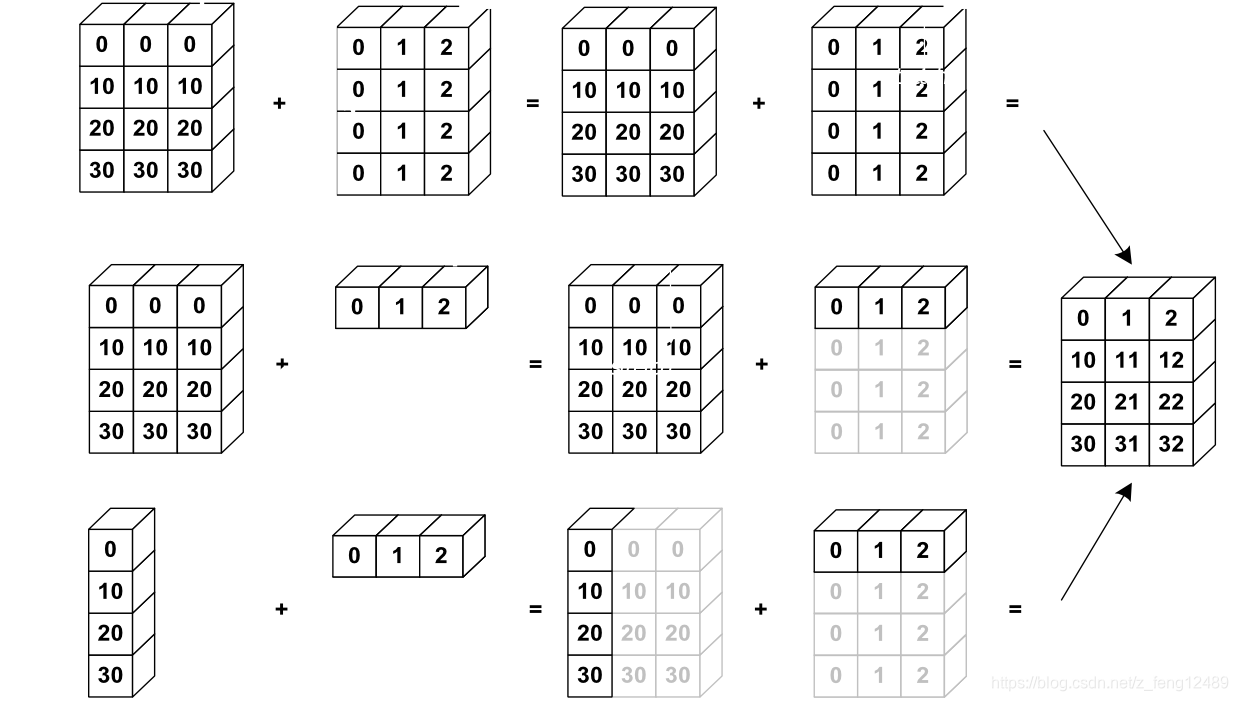版权声明:版权声明:本文为博主原创文章,未经博主允许不得转载。 https://blog.csdn.net/z_feng12489/article/details/89182394
3. 张量高阶操作
Broadcast 机制
Broadcast (expand+withoutcopying) [广播机制]

关键步骤:
- Insert 1 dim ahead (unsqueeze)
- Expand dims with size 1 to same size
- Feature maps: [4, 32, 14, 14]
- Bias: [32, 1, 1] => [1, 32, 1, 1] => [4, 32, 14, 14]
存在意义:
- for actual demanding(实际需求)
- [class,students,scores]
- Addbiasforeverystudents : +5score
- [4,32,8] + [4,32,8]
- [4,32,8] + [5.0]
- memory consumption(节约内存)
- [4,32,8] => 1024
- [5.0] => 1
使用环境
- If current dim=1, expand to same
- If either has no dim, insert one dim and expand to same
- otherwise, NOT broadcasting-able
具体案例
- 情形一:
- [4,32,14,14]
- [1,32,1,1] => [4,32,14,14]
- 情形二:
- [4,32,14,14]
- [14,14] => [1,1,14,14] => [4,32,14,14]
- 情形三:
- [4,32,14,14]
- [2,32,14,14] => error
a = torch.rand(1,3)
b = torch.rand(3,1)
(a+b).shape #torch.Size([3, 3])
a = torch.rand(4, 32, 14, 14)
b = torch.rand(1, 32, 1, 1)
(a+b).shape #torch.Size([4, 32, 14, 14])
a = torch.rand(4, 32, 14, 14)
b = torch.rand(14, 14)
(a+b).shape #torch.Size([4, 32, 14, 14])
a = torch.rand(4, 32, 14, 14)
b = torch.rand(2, 32, 14, 14)
(a+b).shape error
(a+b[0]).shape #torch.Size([4, 32, 14, 14]) 手动指定
a = torch.rand(2, 3, 6, 6)
b = torch.rand(1, 3, 6, 1) 给每一个通道的每一行加上相同的像素值
(a+b).shape
Tensor 分割与合并
Tensor 分割与合并(Merge or splite)
- Cat 合并 , 不增加维度,cat维度可以不同。
a = torch.rand(4, 32, 8) #[classes, students, scores]
b = torch.rand(5, 32, 8)
torch.cat([a, b],dim=0).shape #torch.Size([9, 32, 8])
- Stack 合并,创建新的维度,旧维度必须一致。
a = torch.rand(32, 8) #[students, scores]
b = torch.rand(32, 8)
c = torch.rand(32, 8)
torch.stack([a, b, c],dim=0).shape #torch.Size([3, 32, 8])
- Split 根据长度来拆分。
a = torch.rand(4, 32, 8) #[classes, students, scores]
aa, bb, cc = a.split([1,2,1], dim=0)
aaa, bbb = a.split(2, dim=0)
aa.shape #torch.Size([1, 32, 8])
bb.shape #torch.Size([2, 32, 8])
cc.shape #torch.Size([1, 32, 8])
aaa.shape #torch.Size([2, 32, 8])
bbb.shape #torch.Size([2, 32, 8])
- Chunk 根据数量来拆分。
a = torch.rand(6, 32, 8) #[classes, students, scores]
aa, bb= a.chunk(2, dim=0)
cc, dd, ee =a.split(2, dim=0)
aa.shape #torch.Size([3, 32, 8])
bb.shape #torch.Size([3, 32, 8])
cc.shape #torch.Size([2, 32, 8])
dd.shape #torch.Size([2, 32, 8])
ee.shape #torch.Size([2, 32, 8])
Tensor 运算
tensor 矩阵的基本运算
- Add/minus/multiply/divide
a = torch.rand(4,3)
b = torch.rand(3)
torch.all(torch.eq(a+b, torch.add(a,b))) #tensor(1, dtype=torch.uint8)
a-b #torch.sub
a*b #torch.mul
a/b #torch.div
a//b # 地板除
- Matmul
最后两维做矩阵乘运算,其他符合broadcast机制
a = torch.rand(4,3)
b = torch.rand(3,8)
torch.mm(a, b) #only for 2d
(a @ b).shape #torch.matmul torch.Size([4, 8])
- Pow
a**2 #torch.pow
- Sqrt/rsqrt/exp/log
平方根/平方根的倒数/自然常数幂/自然常数底
a.sqrt() #a**0.5
a.rsqrt()
torch.exp(a) #e**a
- Round 近似运算
a = torch.tensor(3.14) #tensor(3.14)
a.floor(), a.ceil(), a.round() #tensor(3.) tensor(4.) tensor(3.)
a.trunc() #tensor(3.)
a.frac() #tensor(0.1400)
- clamp 数字裁剪
使用环境 ’梯度裁剪’
梯度弥散(梯度非常小 < 0.∗),梯度爆炸(梯度非常大 > ∗00)
打印梯度的 L2 范数观察 (W.grad.norm(2))
grad = torch.rand(3,4)*15
grad.min() #min number
grad.max() #max number
grad.median() #medoan number
grad.clamp(10) #min number is 10
grad.clamp(0, 10) #all numbers is [0,10]
Tensor 统计
- norm
表示范数,不同于 normalize(正则化)

a = torch.full([8], 1)
b = a.reshape(2, 4)
c = b.reshape(2, 2, 2)
a #tensor([1., 1., 1., 1., 1., 1., 1., 1.])
b #tensor([[1., 1., 1., 1.], [1., 1., 1., 1.]])
a.norm(1), b.norm(1), c.norm(1) #tensor(8.)
a.norm(2), b.norm(2), c.norm(2) #tensor(2.8284)
#two parameters norm, dimension
a.norm(1, dim=0) #tensor(8.)
b.norm(1, dim=1) #tensor([4., 4.])
c.norm(2, dim=2) #tensor([[1.4142, 1.4142], [1.4142, 1.4142]])
- max, min, mean, sum, prod(累乘)
a = torch.arange(8).reshape(2,4).float()
a.min() #tensor(0.)
a.max() #tensor(7.)
a.mean() #tensor(3.5)
a.mean(1) #tensor([1.5000, 5.5000])
a.sum() #tensor(28.)
a.prod() #tensor(0.)
- argmin, argmax(参数 dim, keepdim)
a = torch.randn(4, 10) #4张照片 0-9 10个概率值
a.argmin() a.argmax() #无参数默认打平
a.argmax(1) #返回每张照片概率最大的数字
a.argmax(1, keepdim=True) #返回每张照片概率最大的数字并保持维度信息
a.max(1) #返回每张照片最大的概率及数字
- Kthvalue, topk(比 max 返回更多的数据)
a = torch.randn(4, 10) 4张照片 0-9 10个概率值
a.topk(2, dim=1, largest=True)) largest = False 表示最小的 k 个
a.kthvalue(10, dim=1) 返回第10小的概率及位置
- compare (比较操作)
>,<,>=,<=,! =,==
torch.eq() 可 braodcast,返回 0/1 同型
torch.equal() 比较每一值,都相等返回 True
Tensor 高阶操作
- where (GPU 离散复制)
'''
torch.where(condition, x, y) --> Tensor 满足条件取 x,否则取 y
其功能可由for 逻辑功能实现,但运行在CPU,难以高度并行
condition 必须是与 x, y 同型的1/0型 x, y可 broadcast
'''
a = torch.rand(2, 2)
b = torch.ones(2, 2)
c = torch.zeros(2, 2)
torch.where(a>0.5, b, c)
- Gather (GPU 收集查表操作)
'''
torch.gather(input, dim, index, out=None) --> Tensor 查表操作
'''
out[i][j][k] = input[index[i][j][k]][j][k] dim=0
out[i][j][k] = input[i][index[i][j][k]][k] dim=1
out[i][j][k] = input[i][j][index[i][j][k]] dim=2
'''
Gather 查表用来索引全局标签
'''
prob = torch.rand(4, 10) 四张图片十个概率值
idx = prob.topk(3, dim=1)[1]
label = torch.arange(10)+100
torch.gather(label.expand(4, 10), dim=1, index=idx)
# 共四张图片每张查概率最大的三个标签